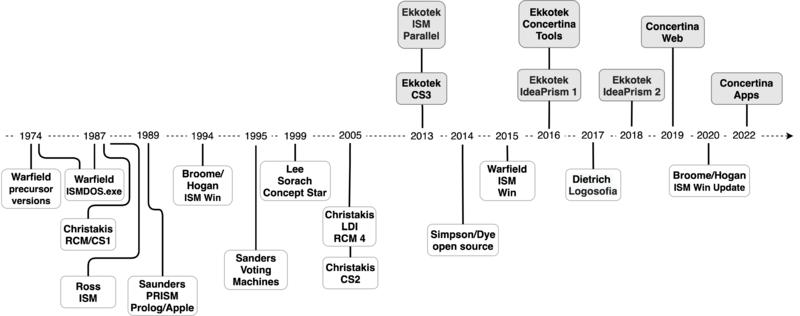ISM Software is software that implements the Interpretive Structural Modeling algorithm.
The ISM Algorithm is embedded in both research and commercial products:
| # | Product | First Release | Vendor | Win | Mac | Web | App | Price | Link |
|---|---|---|---|---|---|---|---|---|---|
| 1 | ISM-DOS | 1992 | John N. Warfield | free | www.gmu.edu/depts/t-iasis/ism/ism.htm | ||||
| 2 | Cogniscope 1 Cogniscope 2 | 1998 | CWA Ltd. Aleco Christakis | ✔ | 10K | globalagoras.org/what-we-do/agoras-process/structured-dialogic-design-software | |||
| 3 | Concept Star | 1999 | Sorach Donna M. Lee | ✔ | trial $25, Single $590 10 users:1984 | http://www.sorach.com/index.html | |||
| 4 | ISM Parallel v1 | 2013 | Ekkotek Laouris | ✔ | ✔ | ✔ | 290 | www.ekkotek.com/index.php/products/wisdom-tools/ism-parallel | |
| 5 | Cogniscope 3 | 2013 | Ekkotek Laouris | ✔ | ✔ | 300-9K | https://www.ekkotek.com/index.php/products/wisdom-tools/cogniscope3 | ||
| 6 | ISM-Win | 2015 | John N. Warfield | ✔ | free | www.jnwarfield.com/ism-software.html | |||
| 7 | IdeaPrism v.1 | 2014 | Future Worlds Center Laouris | ✔ | ✔ | free | www.ideaprism.net | ||
| 8 | IdeaPrism v.2 | 2018 | Future Worlds Center Laouris | ✔ | ✔ | free | www.ideaprism.net | ||
| 9 | Logosofia | 2017 | Min Education, Michgan Jeff Diedrich | ✔ | free | http://logosofia.decisionpoint.design | |||
| 10 | Concertina v1 | 2016 | Ekkotek Laouris | ✔ | 30-100/mo | https://concertina.ekkotek.com |
The implementation of the Structured Democratic Dialogue Process requires the use of software which embeds the ISM algorithm. However, an equally important purpose of the software is to automate the entire process (i.e., not just the ISM stage) by offering friendly and usable interfaces to both the SDD assistants operating it and, more importantly, the participants. Usability in connection with real-time documentation reduces cognitive overload for the participants, thus allowing them to focus entirely on the discussions. The Figure documents software applications in a timeline. The first applications were developed in FORTRAN by David Malone under Warfield’s (1989) supervision. Between 1974 and 1987, many versions of ISM were created in collaboration with his colleagues (i.e., mainly Aleco Christakis and Benjamin Broome, but also at different centres (Warfield, 1995; see also Warfield, 1989). Many of Warfield’s associates who had access to the code made modifications or developed different versions, which, however, did not offer something fundamentally different. Saunders developed an Apple version in PROLOG. Ross used two computers to expand the memory capabilities. Christakis developed Cogniscope in LINGO (scripting language within Macromedia Director) to offer quite friendly interfaces and reports. The first, fully functional, DOS-based ISM software was completed at George Mason University in 1987. Christakis developed an early DOS-based RCM (1987) and later Cogniscope v.1 and v.2 (-2005). Broome and Hogan developed the first windows-based software (1994), which was updated in 2020. Lee and her Canadian company Sorach developed windows-based Concept Star in 1999. The authors’ group has developed the most contemporary applications (depicted above the timeline in Fig. 2), including Cogniscope Software v.3 (2013), ISM Parallel™ (2013: the first App to allow asynchronous ISM), mobile Apps such as IdeaPrism™ (2016) and web-based Concertina (2019). Joseph James Simpson and Kevin Dye developed the first open-source version in 2014 using java. Jeff Dietrich developed web-based Logosofia in 2017. This summary might have missed a few. Several high-profile organizations have developed ad-hoc ISM-based systems to solve problems they were facing, e.g., Battele Memorial Institute, Univ. of Dayton, IBM, Hitachi, Fujitsu, Nippon, Univ. Hokaido, Univ. of Northern Iowa, Univ. of Virginia, Saudi Arabia Gov, Naval Surface Weapons Center, ITESM Mexico, City Univ. London, GeneSys, Northern Telecom, Ford. It should also be noted that the ISM is built in several mathematical libraries, including Matlab.
